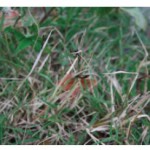Download PDF (PLPA-105)
Have you ever wondered “Why are my shoes black?” after walking through your lawn? Have you ever seen your parts  of your lawn looking like it was charred? No, the black stuff is not ash or soot, but it is the spores of a fungus that is growing on the grass.
of your lawn looking like it was charred? No, the black stuff is not ash or soot, but it is the spores of a fungus that is growing on the grass.
CAUSAL AGENT
The smut fungi is a group of pathogens that cause disease on leaves, sheaths, stems or the inflorescences (seed head). The common problems on turf in Texas are caused primarily by the smut fungi from the genera: Urocystis and Ustilago. The damage they cause is most often observed in the cooler weather of the fall and spring.
Symptoms of smuts vary widely depending on the causal agent, host species and climatic conditions. Most typical damage observed on home lawns are developing seed heads that looked sooty and malformed (loose smut). Occasionally, yellowing stripes may be visible on the leaves. The area that is affected usually appears lighter in color than the surrounding healthy lawn. The size of the affected area can range from a small patch to large patches (10 sq.ft.).
ENVIRONMENTAL CONDITIONS
The fungal spores can survive through the winter in the soil, thatch, or infected plant parts. Spores are typically disseminated by wind and water (splashing rain or irrigation). The spores can also be spread by equipment, people, and animals. The disease becomes evident when temperatures range between 50 – 65°F, spring and fall. At higher temperatures, infected grass usually dies. That is why this problem rarely becomes worse in the Texas summers.
MANAGEMENT
As a preventative measure, a mixture of seeds, or seed blends that incorporate resistant cultivars will greatly minimize  potential disease problems. If a history of this problem has been observed on your lawn, use a balance fertilizer and DO NOT over fertilize. Smut diseases are favored by high nitrogen fertility. Reducing drought stress through proper irrigation practices will help to reduce smut injury. Proper and consistent mowing practices will also reduce incidences of smut, particularly on loose smut that affects the inflorescence. A healthy and vigorous lawn is less likely to get the disease. Chemical treatment is not warranted but there are homeowner chemicals available. Please refer to the label for precautions and proper usage. Additional assistance can be obtained from your local County Extension office.
potential disease problems. If a history of this problem has been observed on your lawn, use a balance fertilizer and DO NOT over fertilize. Smut diseases are favored by high nitrogen fertility. Reducing drought stress through proper irrigation practices will help to reduce smut injury. Proper and consistent mowing practices will also reduce incidences of smut, particularly on loose smut that affects the inflorescence. A healthy and vigorous lawn is less likely to get the disease. Chemical treatment is not warranted but there are homeowner chemicals available. Please refer to the label for precautions and proper usage. Additional assistance can be obtained from your local County Extension office.
Prepared by Dr. Kevin Ong
Assistant Professor and Extension Urban Plant Pathologist
Texas AgriLife Extension Service; The Texas A&M University System
November 9, 2006 (rev. 050609)
The information given herein is for educational purposes only. References to commercial products or trade names are made with the understanding that no discrimination is intended and no endorsement by Texas AgriLife Extension Service personnel is implied.
Educational programs of the Texas AgriLife Extension Service are open to all people without regard to race, color, sex, disability, religion, age, or national origin.
The Texas A&M University System, U.S. Department of Agriculture, and the County Commissioners Courts of Texas Cooperating
